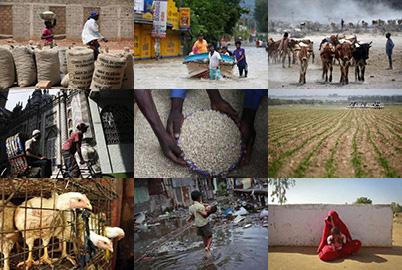"This water is our lifeline; without this irrigation scheme we are hopeless," says one farmer
By Andrew Mambondiyani
NYANYADZI, Zimbabwe, Oct 17 (Thomson Reuters Foundation) - In this drought-prone region of eastern Zimbabwe, relying on rain to grow crops no longer makes sense.
That's one reason Joseph Zviuya, a small-scale farmer in the Nyanyadzi area, looks with satisfaction at the canal near his fields that is now overflowing with irrigation water.
"This water is our lifeline; without this irrigation scheme we are hopeless," the farmer in Zimbabwe's Chimanimani district told the Thomson Reuters Foundation.
As climate change has brought worsening droughts over the last decade, Zimbabwe is looking to rebuild parts of its damaged or abandoned irrigation network as a bulwark against hunger.
Zviuya, a former district councillor, is one of more than 850 small-scale farmers who now depend on the rehabbed Nyanyadzi irrigation scheme to bring in a harvest.
For more than a decade, the system was not fully operational after silt built up in the network's water sources and along its irrigation canals. The problem is one many irrigation schemes across the country face.
Farmers upstream on the Nyanyadzi River, which provides the water for the irrigation network, have for years cultivated the river banks, resulting in erosion and increasing blockages of irrigation canals with sand and soil washed downstream.
Now, however, the irrigation system's canals and part of the river have been cleared and silt traps built upstream to catch some of the sand moving downstream. Pipes have also been installed along some of the canals to carry and protect water.
"This irrigation scheme was affected by a critical shortage of water due to siltation of the river before," Zviuya said. "This is a perennial problem but this time we have managed to address the root cause affecting viability of the irrigation scheme".
"CLIMATE-SMART" CHANGES
The irrigation rehabilitation programme is part of a "climate-smart village" effort to scale up climate change adaptation, backed by anti-poverty charity Oxfam in partnership with the Southern Alliance for Indigenous Resources (SAFIRE) and Zimbabwe's government, and funded by the United Nations Development Programme.
The adaptation scale-up effort, which began in 2014 and ends in October 2018, has targeted drought-prone areas in Buhera and Chimanimani districts in Zimbabwe's Manicaland province and Chiredzi district in Masvingo province.
"Climate-smart" changes are being put in place in six villages, including three in Chiredzi district, two in Chimanimani and two in Buhera.
In Nyanyadzi, more than 400 irrigated hectares are now planted to crops, including wheat, beans, tomatoes, onions, okra and various leaf vegetables.
Another farmer in the irrigation scheme, Joseph Mashakada, said a steady supply of irrigation water has now allowed farmers to get consistently good harvests.
"I have a good crop of okra, and I think I will be able to get enough money to feed my family and send my children to school," Mashakada said.
Shupikai Karenyi, a farmer who is expecting nearly two tonnes of wheat from his piece of land this season, said the effort needed to be expanded to help other farmers in the area. He said a bigger dam along the Nyanyadzi River would be a particular help.
"We are happy that the irrigation scheme is now fully operational. The water is driven by gravity and we are not running any expenses for electricity to pump the water," Karenyi said.
Government experts say farmers in the Nyanyadzi Irrigation Scheme are likely to see their annual income from farming rise from around $2,800 before the project to more than $6,400 by the fourth year it is working, if they plant year round.
Aaron Mwanasawani, a technician from Zimbabwe's Irrigation Department, said the project had gone further than previous de-silting efforts of irrigation canals in that it also focused on preventing canals from clogging again.
That is happening through changes such as installing silt traps and planting erosion-prone riverbanks to plants that can hold the soil, he said.
(Reporting by Andrew Mambondiyani; editing by Laurie Goering :; Please credit the Thomson Reuters Foundation, the charitable arm of Thomson Reuters, that covers humanitarian news, climate change, resilience, women's rights, trafficking and property rights. Visit http://news.trust.org/climate)
Our Standards: The Thomson Reuters Trust Principles.

